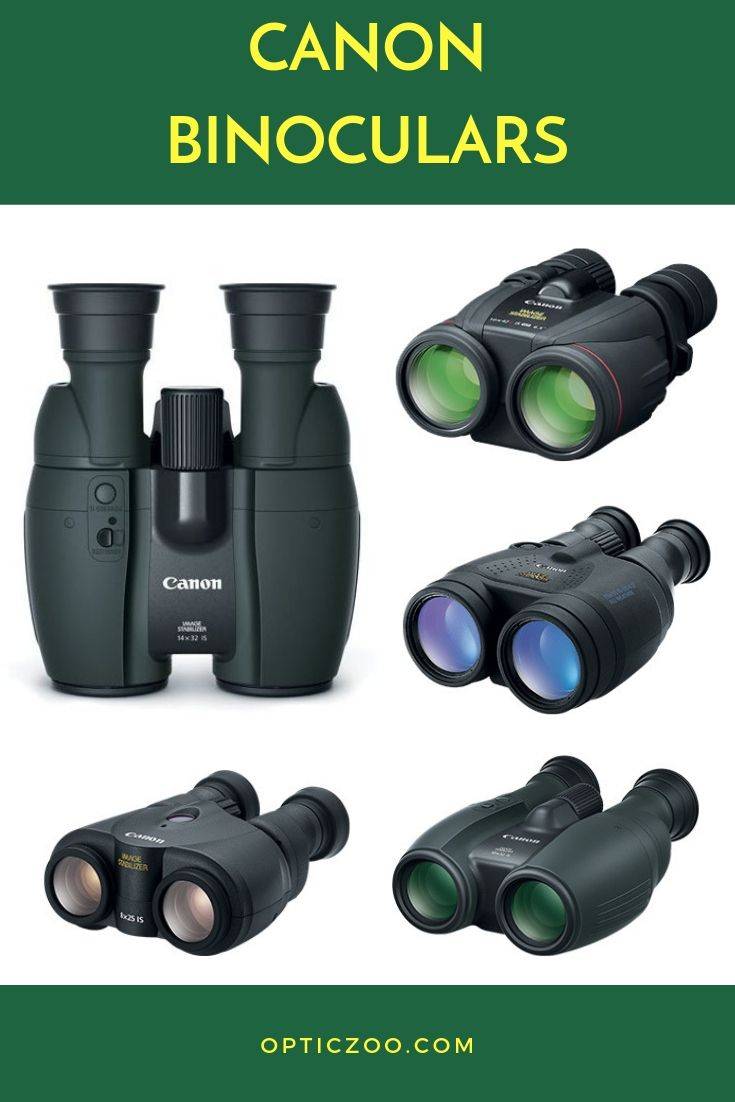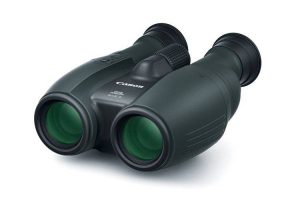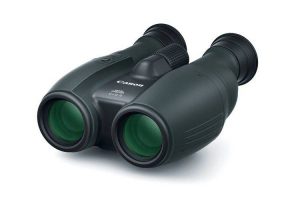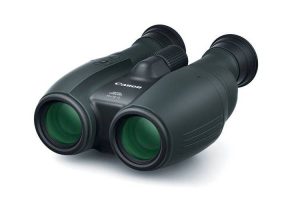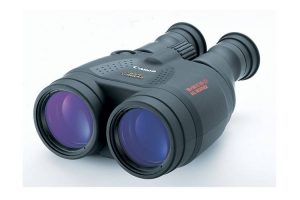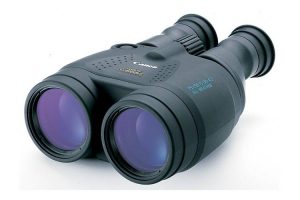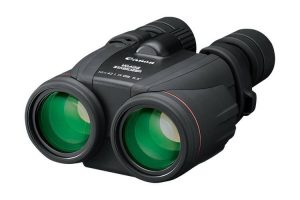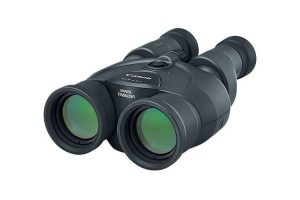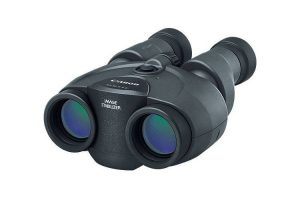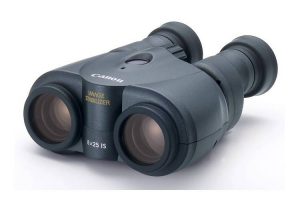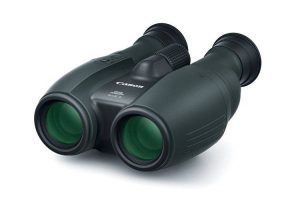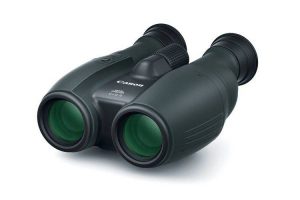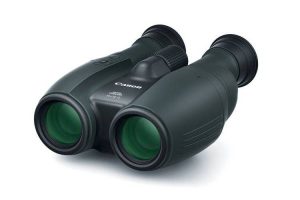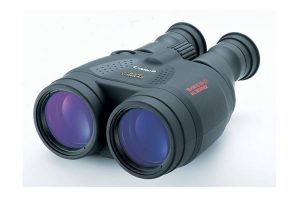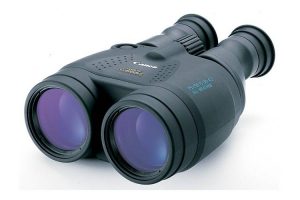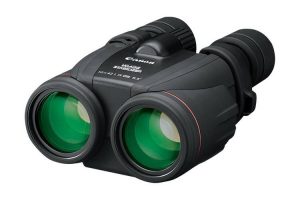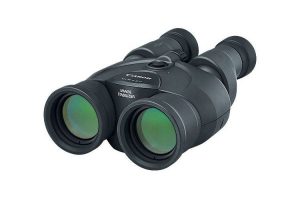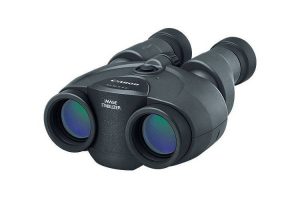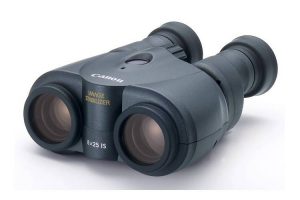 Binoculars give us seats to the greatest attractions of Heaven and Earth, but there isn’t one pair that can do everything.
Binoculars give us seats to the greatest attractions of Heaven and Earth, but there isn’t one pair that can do everything.
Suitability isn’t only a matter of higher magnification: you need differently configured binos for different forms of viewing.
That’s great: but not everyone has the time and money to spend on trial-and-error testing with expensive glass.
Finding a preferred manufacturer with a comprehensive line gives you a headstart on choosing the right binoculars both today and tomorrow.
Canon is an venerable name in consumer optical equipment. Established in 1937, the company was the first major manufacturer to implement image stabilization (IS) in its produces, and maintains the foremost line of IS binoculars.
Let’s look at the Canon line-up and see what makes their binoculars so popular — and, maybe, where they might be letting us down.
Types of Binoculars made by Canon
Binoculars come with different configurations for specific uses, though many useful features overlap more than one category. Here are main categories that Canon shows up in.
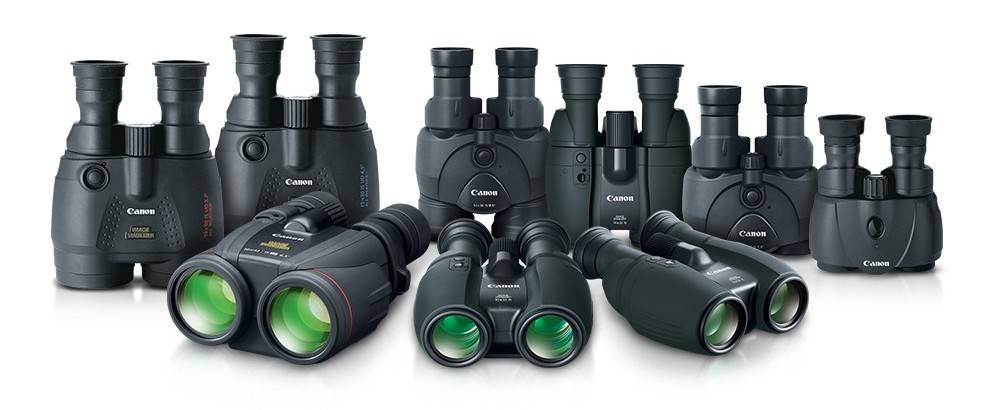
| Char | |||||||||
|---|---|---|---|---|---|---|---|---|---|
| Magnification | 10x | 12x | 14x | 18x | 15x | 10x | 12x | 10x | 8x |
| Objective Lens Effective Diameter | 32 mm | 32 mm | 32 mm | 50 mm | 50 mm | 42 mm | 36 mm | 30 mm | 25 mm |
| Image Stabilizer Function | Shift method | Shift method | Shift method | Vari-angle Prism | Vari-angle Prism | Vari-angle Prism | Vari-angle Prism | Vari-angle Prism | Tilt method |
| Eye Relief | 14.5 mm | 14.5 mm | 14.5 mm | 15.0 mm | 15.0 mm | 16.0 mm | 14.5 mm | 14.5 mm | 13.5 mm |
| Pupil Diameter | 3.2 mm | 2.7 mm | 2.3 mm | 2.8 mm | 3.3 mm | 4.2 mm | 3.0 mm | 3.2 mm | 3.1 mm |
| Closest Focusing Distance | 6.6 ft./2.0 m | 6.6 ft./2.0 m | 6.6 ft./2.0 m | 19.7 ft./6.0 m | 19.7 ft./6.0 m | 8.2 ft./2.5 m | 19.7 ft./6.0 m | 13.8 ft./4.2 m | 11.5 ft./3.5 m |
| Apparent Field of View | 55.3º | 55.3º | 55.5º | 60.3º | 61.0º | 59.2º | 55.3º | 55.3º | 49.5º |
| Real Field of View / 1000m Field of View | 6.0º/105 m | 5.0º/87 m | 4.3º/75 m | 3.7º/65 m | 4.5º/79 m | 6.5º/114 m | 5.0º/87.5 m | 6.0º/105 m | 6.6º/115 m |
| Features | Super Spectra Coating | Super Spectra Coating | Super Spectra Coating | Super Spectra Coating, Tripod Socket, UD Lens, All weather specs | Super Spectra Coating, Tripod Socket, UD Lens, All weather specs | Super Spectra Coating, Tripod Socket, UD Lens, Waterproof specs, Anti-Fog Eyepiece AE-B1 | Super Spectra Coating | Super Spectra Coating | Super Spectra Coating |
| Power Source (for IS) | 2 AA batteries | 2 AA batteries | 2 AA batteries | 2 AA batteries | 2 AA batteries | 2 AA batteries | 2 AA batteries | 2 AA batteries | 1 CR123A Lithium-ion battery |
| Weight (excluding batteries) | 27.5 oz./780 g | 27.5 oz./780 g | 27.3 oz./775 g | 41.6 oz./1180 g | 41.6 oz./1180 g | 39.2 oz./1110 g | 23.3 oz./660 g | 21.2 oz./600 g | 17.3 oz./490 g |
Astronomy
Stargazing doesn’t necessarily require high-powered magnification, but good celestial viewing does need a clear, bright, uniform image with accurate color rendering. Canon has several binoculars with the optical performance to reach for the stars.
[wpsm_column size=”one-half”][wpsm_pros title=”Canon’s PROS:”]
- High Optical Performance
- Mid-range Astronomical magnification
- Bright, accurate color rendition
- IS handheld stargazing
- Consistent high-quality image across the FOV
[/wpsm_pros][/wpsm_column][wpsm_column size=”one-half” position=”last”][wpsm_cons title=”Canon’s CONS:”]
- No higher magnification than 18x
- IS is less important with mounted binos
- Inconsistent low-light capacity
[/wpsm_cons][/wpsm_column]
Birdwatching
Watchers of wildlife need sharp, colorful views with quick, efficient focusing. They also want good performance in low light, and a wide Field of View (FOV) to scan the landscape and find targets easily.

Canon has some exceptional binos specifically made for wildlife spotting … and their famous IS gives them an extra advantage.
[wpsm_column size=”one-half”][wpsm_pros title=”Canon’s PROS:”]
- High Optical Performance
- IS for quick and convenient viewing
- Optimal lower-magnification models available
- All-weather models available
- Suitable close-range focus
[/wpsm_pros][/wpsm_column][wpsm_column size=”one-half” position=”last”][wpsm_cons title=”Canon’s CONS:”]
- Low-light performance varies
- FOV restrictions in some units
- Several otherwise suitable models lack weatherproofing
[/wpsm_cons][/wpsm_column]
Hunting
A good balance of superior optics and durability is needed for high performance while hunting. Low-light capacity and excellent color rendition are important too. Most of Canon’s All-Weather models can handle the job.
[wpsm_column size=”one-half”][wpsm_pros title=”Canon’s PROS:”]
- High Optical Performance
- IS for viewing on-the-fly
- Optimal lower-magnification models available
- All-weather models available
- Suitable close-range focus
[/wpsm_pros][/wpsm_column][wpsm_column size=”one-half” position=”last”][wpsm_cons title=”Canon’s CONS:”]
- Low-light performance is inconsistent
- FOV is too restricted for a general field glass
- Most suitable models lack weatherproofing
[/wpsm_cons][/wpsm_column]
Canon’s Line-up
[wpsm_box type=”dashed_border” float=”none” text_align=”left” width=”100%” ]
Canon 10×32 IS
[wpsm_column size=”one-half”]
[/wpsm_column]
[wpsm_column size=”one-half” position=”last”]
[wpsm_list type=”check” hover=”1″ gap=”medium”]
- Lens-Shift Image Stabilization
- Field-Flattener Lens System
- Super Spectra Multi-Coated Optics
- Normal and Powered IS Modes
- Simple 2-Button User Interface
- Fold-Down Rubber Eyecups
[wpsm_button color=”blue” size=”medium” link=”https://www.amazon.com/dp/B0744NH94W/?tag=opticzoo-20″ icon=”none” class=”” border_radius=”0 px” target=”_blank” rel=”nofollow”]Check For Deals on Amazon[/wpsm_button]
[rehub_affbtn btn_text=”Check For Deals on B&H Photovideo” btn_url=”https://bhpho.to/30t09A6″ target=”_blank” ]
[/wpsm_column]
[/wpsm_box]
The Canon 10×32 IS are versatile binos with a focus on birders. They are one of Canon’s newest models, and feature its next-generation Lens Shift Image Stabilization system.
This method uses a moveable lens and an anti-vibration gyro to deliver a sharper and more stable image.
The new design dramatically shortens the close focus range to 6.6 feet (2.0m).
[wpsm_box type=”info” float=”none” text_align=”left”]
The optical quality and consistency across the FOV are excellent and, together with the stabilized image’s accurate colors and high contrast, provide breathtaking sights.
[/wpsm_box]
The FOV is adequate for scanning and finding targets, and the 14.5mm eye relief is adequate — though the bulky fold-up eyecups are not universally beloved.
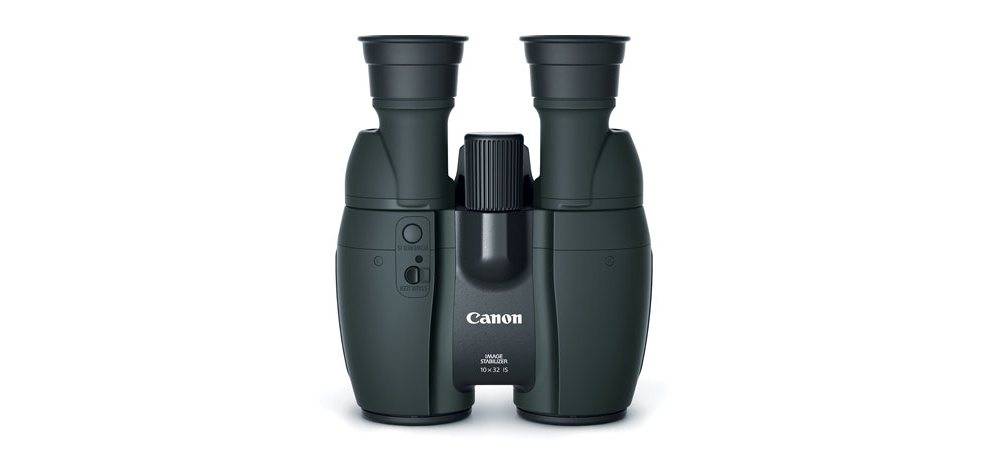 The Canon 10×32 IS marginal low-light performance makes its best for daytime users, but the real concern is the lack of waterproofing that older Canons provided.
The Canon 10×32 IS marginal low-light performance makes its best for daytime users, but the real concern is the lack of waterproofing that older Canons provided.
It’s not clear why the change was made, but it detracts from the ruggedness of an otherwise well-made bino. It’s a pricey but optically superior choice for fair weather watching, but forget seeing the early birds and don’t go out in the rain with them.
[wpsm_box type=”dashed_border” float=”none” text_align=”left” width=”100%” ]
Canon 12×32 IS
[wpsm_column size=”one-half”]
[/wpsm_column]
[wpsm_column size=”one-half” position=”last”]
[wpsm_list type=”check” hover=”1″ gap=”medium”]
- Lens-Shift Image Stabilization
- Field-Flattener Lens System
- Super Spectra Multi-Coated Optics
- Normal and Powered IS Modes
- Simple 2-Button User Interface
- Large Center Focusing Wheel
[wpsm_button color=”blue” size=”medium” link=”https://www.amazon.com/dp/B07CRN8C8K/?tag=opticzoo-20″ icon=”none” class=”” border_radius=”0 px” target=”_blank” rel=”nofollow”]Check For Deals on Amazon[/wpsm_button]
[rehub_affbtn btn_text=”Check For Deals on B&H Photovideo” btn_url=”https://bhpho.to/30rLvc9″ target=”_blank” ]
[/wpsm_column]
[/wpsm_box]
The Canon 12×32 IS is a birdwatcher’s model that bumps up the magnification with little loss of optical quality and minimal reduction in the FOV.
The optics and light-transmission qualities share the advantages of Canon’s other recently introduced Shift-method IS binos.
The image’s clarity and brightness are striking, and its colors seem enhanced.
[wpsm_box type=”info” float=”none” text_align=”left”]
The new Lens Shift method of IS smooths out the shakiness you might otherwise see at 12x, which makes them more versatile than ordinary 12x glasses.
[/wpsm_box]
Though the FOV is slightly less than the 10x model, and it’s low-light performance is only average, Canon’s superior image quality holds true here.
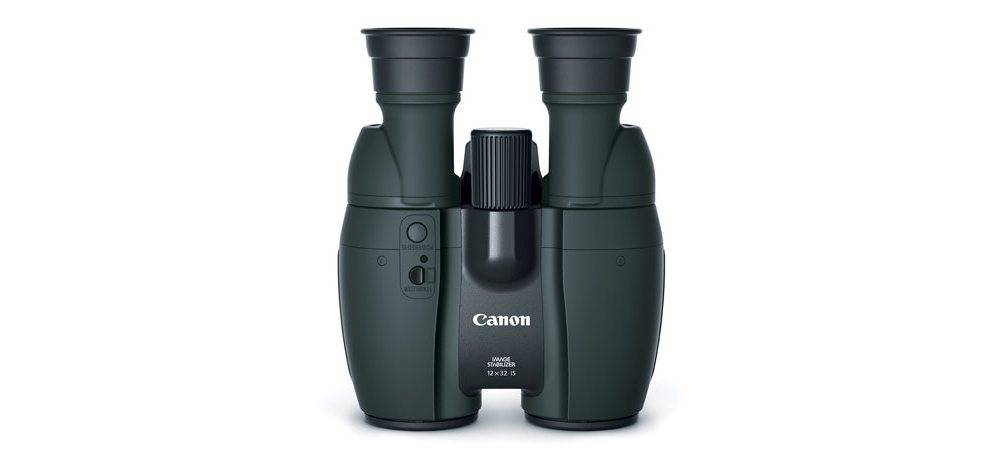 As field glasses, you necessarily lose a bit of view-sweeping ability due to higher magnification — but you get some back with the impressive stabilization features.
As field glasses, you necessarily lose a bit of view-sweeping ability due to higher magnification — but you get some back with the impressive stabilization features.
Don’t take them into the dark or bad weather, though: without weather-proofing, they are closer to a specialty glass than a rugged all-rounder.
[wpsm_box type=”dashed_border” float=”none” text_align=”left” width=”100%” ]
Canon 14×32 IS
[wpsm_column size=”one-half”]
[/wpsm_column]
[wpsm_column size=”one-half” position=”last”]
[wpsm_list type=”check” hover=”1″ gap=”medium”]
- Lens-Shift Image Stabilization
- Field-Flattener Lens System
- Super Spectra Multi-Coated Optics
- Normal and Powered IS Modes
- Simple 2-Button User Interface
- Fold-Down Rubber Eyecups
[wpsm_button color=”blue” size=”medium” link=”https://www.amazon.com/dp/B0744MJ943/?tag=opticzoo-20″ icon=”none” class=”” border_radius=”0 px” target=”_blank” rel=”nofollow”]Check For Deals on Amazon[/wpsm_button]
[rehub_affbtn btn_text=”Check For Deals on B&H Photovideo” btn_url=”https://bhpho.to/30sFSe1″ target=”_blank” ]
[/wpsm_column]
[/wpsm_box]
This model boasts the highest magnification in Canon’s new range of Shift-stabilized binoculars, and they have the same excellent birdwatching optics as the two lower-mag binoculars.
Canon 14×32 IS also has the same clear, crisp picture and accurate color rendition of the group, with no noticeable degradation due to its higher power.
The question often asked about a 14x-magnification is … why? The optimal field glass for finding targets uses lower magnification to catch more of the horizon at once: 14x narrows the view.
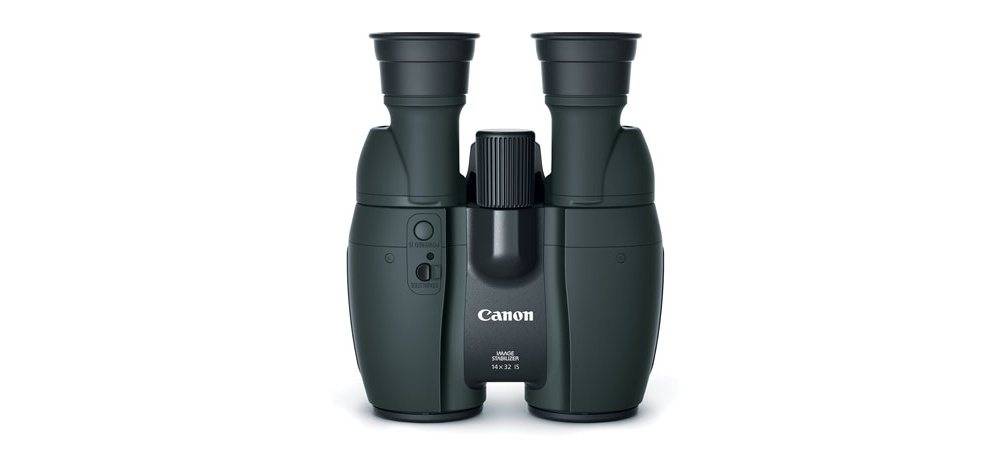 And, though 14x is a high magnification for birding, it’s not usually enough for stargazing. The low-light performance takes a hit, too. Why bother? The reason this 14x model is special is Canon’s famous IS.
And, though 14x is a high magnification for birding, it’s not usually enough for stargazing. The low-light performance takes a hit, too. Why bother? The reason this 14x model is special is Canon’s famous IS.
[wpsm_box type=”info” float=”none” text_align=”left”]
This high-tech feature practically eliminates the hand-shaking that hobbles unequipped binos at that magnification … and provides startlingly bright and clear close-ups over a large range.
[/wpsm_box]
The expensive Shift-method models aren’t for hunting or rugged use — or even a light rain — but few binos at any price can equal their image quality on a clear day.
[wpsm_box type=”dashed_border” float=”none” text_align=”left” width=”100%” ]
Canon 18×50 IS AW
[wpsm_column size=”one-half”]
[/wpsm_column]
[wpsm_column size=”one-half” position=”last”]
[wpsm_list type=”check” hover=”1″ gap=”medium”]
- Porro Prism & Wide Angle
- 3.7° Angle of View
- ±0.7° Image Stabilization
- Field-Flattening Lenses
- UD Ultra-Low Dispersion Element
- Weatherproof Housing
[wpsm_button color=”blue” size=”medium” link=”https://www.amazon.com/dp/B00004THDE/?tag=opticzoo-20″ icon=”none” class=”” border_radius=”0 px” target=”_blank” rel=”nofollow”]Check For Deals on Amazon[/wpsm_button]
[rehub_affbtn btn_text=”Check For Deals on B&H Photovideo” btn_url=”https://bhpho.to/30nOVNf” target=”_blank” ]
[/wpsm_column]
[/wpsm_box]
Canon 18×50 IS AW is the highest magnification IS bino in the Canon line-up, and they’ve become an all-weather favorite useful for astronomy or to back up a low-mag field glass while hunting.
The 18×50’s Vari-angle Prism keeps the image stable for hand-held viewing, making it possible to do handheld viewing even at this higher magnification — while still keeping Canon’s superior optical performance and color faithfulness.
[wpsm_box type=”info” float=”none” text_align=”left”]
The ample 50mm objective lens and Super Spectra coating boosts low-light capacity, too.
[/wpsm_box]
Though it’s not an economy model, the durable waterproof construction makes it suitable for hunting or birding: it’s an excellent second glass to count horns or whiskers as the case may be.
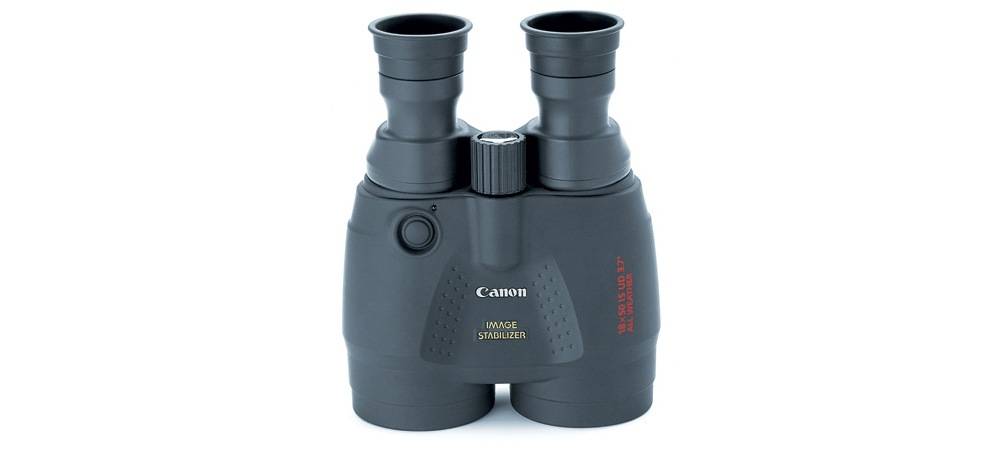 It’s one of the most versatile 18x’s on the market, though it’s a little overpowered for birding or as a general bino. The model’s high-quality optics and low-light performance make it a popular choice for stargazing.
It’s one of the most versatile 18x’s on the market, though it’s a little overpowered for birding or as a general bino. The model’s high-quality optics and low-light performance make it a popular choice for stargazing.
[wpsm_box type=”dashed_border” float=”none” text_align=”left” width=”100%” ]
Canon 15×50 IS AW
[wpsm_column size=”one-half”]
[/wpsm_column]
[wpsm_column size=”one-half” position=”last”]
[wpsm_list type=”check” hover=”1″ gap=”medium”]
- Electronic Image Stabilization
- Ultra-Low Dispersion Lead-Free Glass
- Porro Prism Optical Path
- Fully Super Spectra Coatings
- Weatherproof Slip-Resistant Armor
- Fold-Down Rubber Eyecups
[wpsm_button color=”blue” size=”medium” link=”https://www.amazon.com/dp/B00006I53P/?tag=opticzoo-20″ icon=”none” class=”” border_radius=”0 px” target=”_blank” rel=”nofollow”]Check For Deals on Amazon[/wpsm_button]
[rehub_affbtn btn_text=”Check For Deals on B&H Photovideo” btn_url=”https://bhpho.to/30siZrd” target=”_blank” ]
[/wpsm_column]
[/wpsm_box]
Canon 15×50 IS AW is this versatile, durable classic has been popular for years due to its convenience and sharp views in all kinds of weather.
Many astronomy buffs think that 15×50 is an ideal configuration for binoculars — another reason why this model is one of Canon’s bestsellers for stargazing.
The famous Canon stabilization features combine with the maker’s superior optical design to deliver exceptionally bright and crisp celestial images.
[wpsm_box type=”info” float=”none” text_align=”left”]
Weather-proofing is another highlight of these binos: the durable casing and quality build make them a suitably rugged choice for hunting.
[/wpsm_box]
Canon 15×50 IS AW is solid low-light performance is good for astronomical viewing, and also lets birders see well before dawn or after dusk.
The stabilization system makes these binos a bit heavy — though you don’t need a tripod, you may want one anyway. The eye relief is generally adequate at 15mm, though the eyecups are a bit stiff for long viewing.
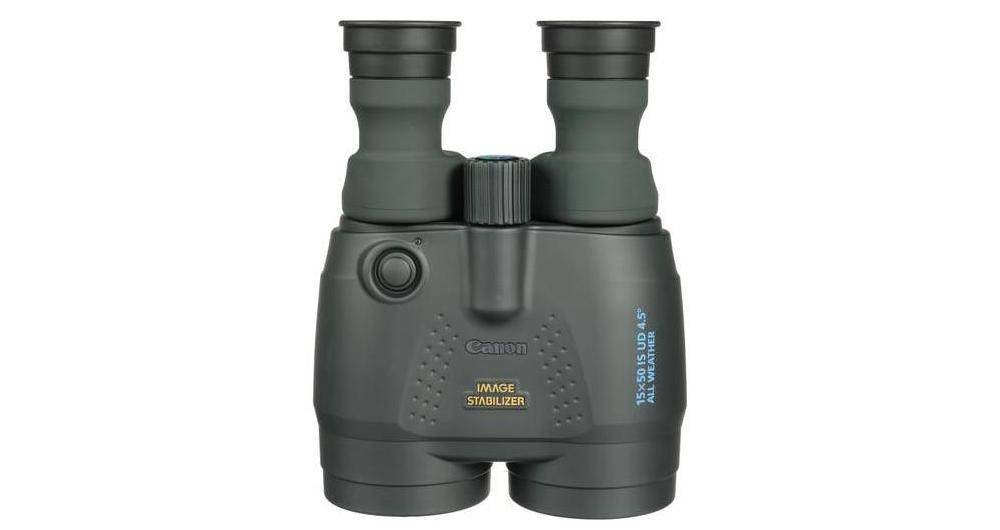 These are great binos if you want higher magnification but don’t want to lug a tripod around, and don’t mind paying the difference. They are nice primary binos for hunting or birding, but their favored home is in the stars.
These are great binos if you want higher magnification but don’t want to lug a tripod around, and don’t mind paying the difference. They are nice primary binos for hunting or birding, but their favored home is in the stars.
[wpsm_box type=”dashed_border” float=”none” text_align=”left” width=”100%” ]
Canon 10x42L IS WP
[wpsm_column size=”one-half”]
[/wpsm_column]
[wpsm_column size=”one-half” position=”last”]
[wpsm_list type=”check” hover=”1″ gap=”medium”]
- Electronic Image Stabilization
- Ultra-Low Dispersion Lead-Free Glass
- Porro Prism Optical Path
- Fully Super Spectra Coatings
- Twist-Up Eyecups
- Waterproof & Fogproof
[wpsm_button color=”blue” size=”medium” link=”https://www.amazon.com/dp/B0007W4IW2/?tag=opticzoo-20″ icon=”none” class=”” border_radius=”0 px” target=”_blank” rel=”nofollow”]Check For Deals on Amazon[/wpsm_button]
[rehub_affbtn btn_text=”Check For Deals on B&H Photovideo” btn_url=”https://bhpho.to/30nNFK1″ target=”_blank” ]
[/wpsm_column]
[/wpsm_box]
Canon’s highest-end (and highest-priced) binoculars, the 10x42L IS offers the best optical performance of any handheld consumer model.
Canon 10x42L IS WP is the only bino with Canon’s professional-grade “L glass” and its Ultra-low Dispersion assembly.
The wide FOV and bright, crisp image are honestly stunning, which is why this model has been popular with both sky- and wildlife-watchers for years.
Solid, waterproof construction makes it convenient to toss these binos in your gear bag for a hunting or camping trip. Seriously: it is recommended that you wash them off by dunking them in a bucket of water.
[wpsm_box type=”info” float=”none” text_align=”left”]
The vaunted L glass produces exceptionally clear and pin-point accurate images to make them excellent astronomy bins too.
[/wpsm_box]
These are expensive bins that represent a real investment. They are a bit heavy and bulky, though the smooth IS makes up most of the difference. Some, a cranky few, say the rounded profile isn’t a work of great aesthetic beauty.
The ergonomics are unique, too: if you’re seriously considering these binoculars, be sure to try them out first.
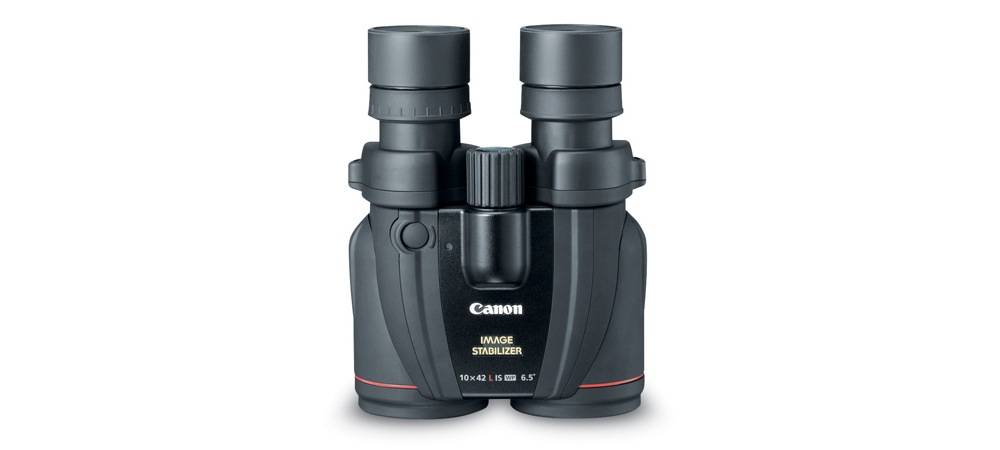 The 10x42L helped make Canon’s reputation as the world’s leader in image stabilization — the outstanding views possible with IS has set a standard for hand-held consumer glass.
The 10x42L helped make Canon’s reputation as the world’s leader in image stabilization — the outstanding views possible with IS has set a standard for hand-held consumer glass.
If you have the means, these versatile binos hit the trifecta: pleasing stargazers, hunters, and birders alike.
[wpsm_box type=”dashed_border” float=”none” text_align=”left” width=”100%” ]
Canon 12×36 IS III
[wpsm_column size=”one-half”]
[/wpsm_column]
[wpsm_column size=”one-half” position=”last”]
[wpsm_list type=”check” hover=”1″ gap=”medium”]
- Vari-Angle Prism Image Stabilization
- Eco-Friendly Lead-Free Glass
- Super Spectra Multicoated Optics
- Doublet Field-Flattener Lenses
- Center Focus Wheel
[wpsm_button color=”blue” size=”medium” link=”https://www.amazon.com/dp/B00XOD5C1W/?tag=opticzoo-20″ icon=”none” class=”” border_radius=”0 px” target=”_blank” rel=”nofollow”]Check For Deals on Amazon[/wpsm_button]
[rehub_affbtn btn_text=”Check For Deals on B&H Photovideo” btn_url=”https://bhpho.to/30wnzEI” target=”_blank” ]
[/wpsm_column]
[/wpsm_box]
This Canon 12×36 IS III model is compact and lightweight with excellent features for bird-watching and general stargazing.
Its stepped-up magnification brings images of wildlife close-up, which can be an asset for a hunting glass, too.
Canon’s IS is the key that makes this pair’s increased magnification fun, because the image is as clear, bright, and steady as that of a lower-mag pair.
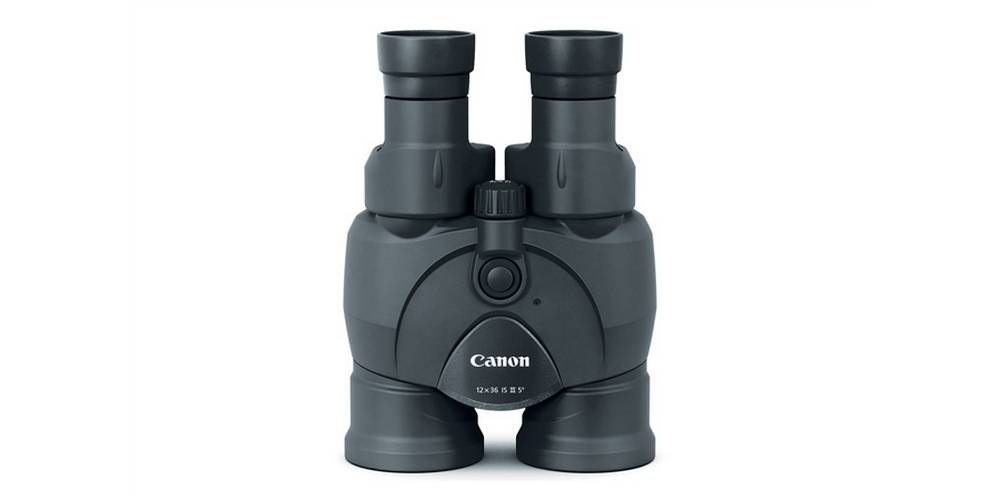 Some users find they are a bit large and bulky for all-day use, but they are quite lightweight for an IS bino at 23.3 oz (660g).
Some users find they are a bit large and bulky for all-day use, but they are quite lightweight for an IS bino at 23.3 oz (660g).
[wpsm_box type=”warning” float=”none” text_align=”left”]
The main letdown is the lack of weather-proofing — it’s hard to see these binos as a reliable hunting pair.
[/wpsm_box]
Overall Canon 12×36 IS III is best for general fair-weather celestial viewing or intense daytime birding, where the image-stabilized, crisp and brilliant views can shine.
[wpsm_box type=”dashed_border” float=”none” text_align=”left” width=”100%” ]
Canon 10×30 IS II
[wpsm_column size=”one-half”]
[/wpsm_column]
[wpsm_column size=”one-half” position=”last”]
[wpsm_list type=”check” hover=”1″ gap=”medium”]
- Vari-Angle Prism Image Stabilization
- Eco-Friendly Lead-Free Glass
- Super Spectra Multicoated Optics
- Doublet Field-Flattener Lenses
- Center Focus Wheel
[wpsm_button color=”blue” size=”medium” link=”https://www.amazon.com/dp/B00XOGP13S/?tag=opticzoo-20″ icon=”none” class=”” border_radius=”0 px” target=”_blank” rel=”nofollow”]Check For Deals on Amazon[/wpsm_button]
[rehub_affbtn btn_text=”Check For Deals on B&H Photovideo” btn_url=”https://bhpho.to/30uq0HM” target=”_blank” ]
[/wpsm_column]
[/wpsm_box]
Canon 10×30 IS II bins are the compact, lightweight bins are one of Canon’s “economy” models, relatively speaking.
They are an update to a previous edition, with minor upgrades including longer battery life and quick-start stabilization, but the excellent optical performance remains.
Besides image stabilization and optical quality, size and ergonomics are important features in this model.
The long eye relief accommodates eyeglass-wearers, and the ergonomically-placed IS buttons are on top behind the center-mounted focusing wheel.
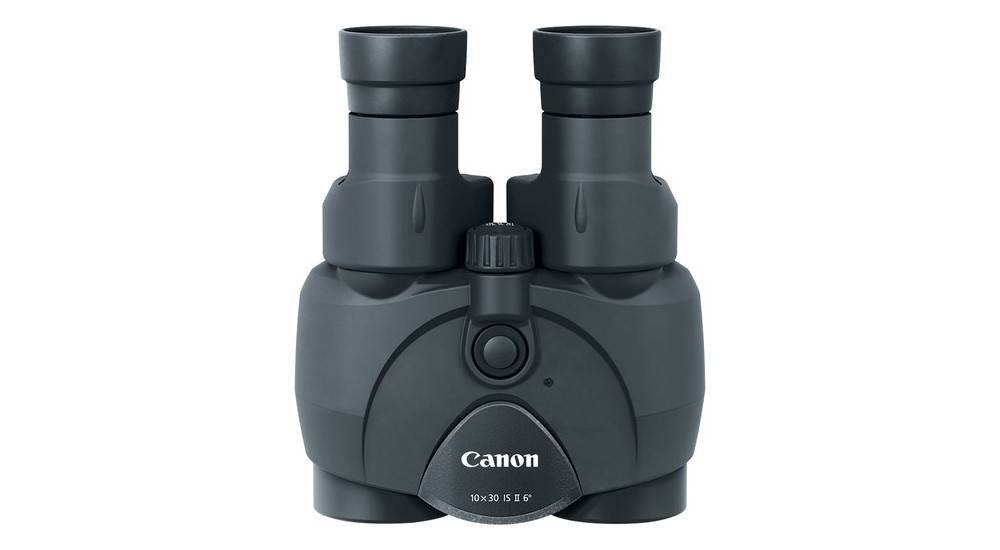 Though it’s not exactly featherweight at 21.2 oz (600g), these are light for an image stabilized bin and are suitable for carrying.
Though it’s not exactly featherweight at 21.2 oz (600g), these are light for an image stabilized bin and are suitable for carrying.
[wpsm_box type=”warning” float=”none” text_align=”left”]
Unfortunately the unit is not waterproof — it needs to be stowed safely in padding.
[/wpsm_box]
This limits the 10×30 IS II’s use as a rough-and-tumble bino for hunting, but the optical quality is all you could want for general stargazing and fair-weather birding.
[wpsm_box type=”dashed_border” float=”none” text_align=”left” width=”100%” ]
Canon 8×25 IS
[wpsm_column size=”one-half”]
[/wpsm_column]
[wpsm_column size=”one-half” position=”last”]
[wpsm_list type=”check” hover=”1″ gap=”medium”]
- Porro Prism & Multicoated
- Optical Image Stabilizer
- Super Spectra Coatings
- Doublet Field Flattener Lens
- Textured Rubber Coating Provides Grip
- Rounded Design
[wpsm_button color=”blue” size=”medium” link=”https://www.amazon.com/dp/B000063YA5/?tag=opticzoo-20″ icon=”none” class=”” border_radius=”0 px” target=”_blank” rel=”nofollow”]Check For Deals on Amazon[/wpsm_button]
[rehub_affbtn btn_text=”Check For Deals on B&H Photovideo” btn_url=”https://bhpho.to/2KTAXgZ” target=”_blank” ]
[/wpsm_column]
[/wpsm_box]
As the lowest magnification binoculars in the Canon lineup, the Canon 8×25 IS has some advantages all its own.
It’s also the smallest and lightest pair, due to the unique “Tilt” stabilization that pares down weight and size: you can easily slip these in a backpack or purse for everyday use.
Canon’s quality all-glass optical construction uses Super Spectra Multi-coating to maximize brightness and clarity.
[wpsm_box type=”info” float=”none” text_align=”left”]
The image is sharp and renders colors accurately, and the stabilized image counteracts normal handheld shaking.
[/wpsm_box]
The 8×25’s are powered by a Lithium-ion battery, which makes them a bit less convenient (Tip: Keep an extra set handy). They also lack waterproofing or an all-weather construction, so they aren’t dependable on safari — but these are quibbles.
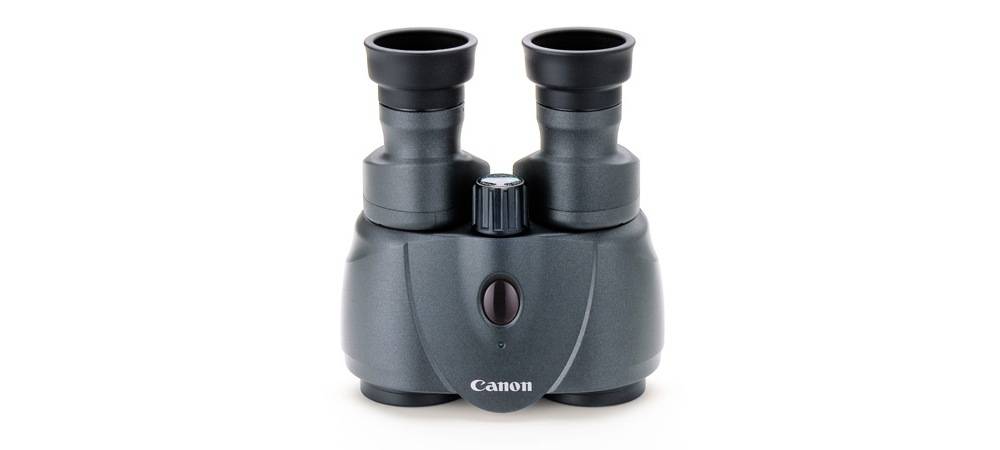 At this magnification and clarity, the binoculars are excellent for general astronomy and birding … and happen to be one of the top indoor “opera glasses” ever made.
At this magnification and clarity, the binoculars are excellent for general astronomy and birding … and happen to be one of the top indoor “opera glasses” ever made.
Canon Features
Image Stabilization
Canon pioneered image stabilization, and they lead the market in this amazing technology.
Even after you get used to seeing the uncanny stillness of the screen, you are reminded every time you hand them to a friend and hear exclamations of surprise. It’s fun.
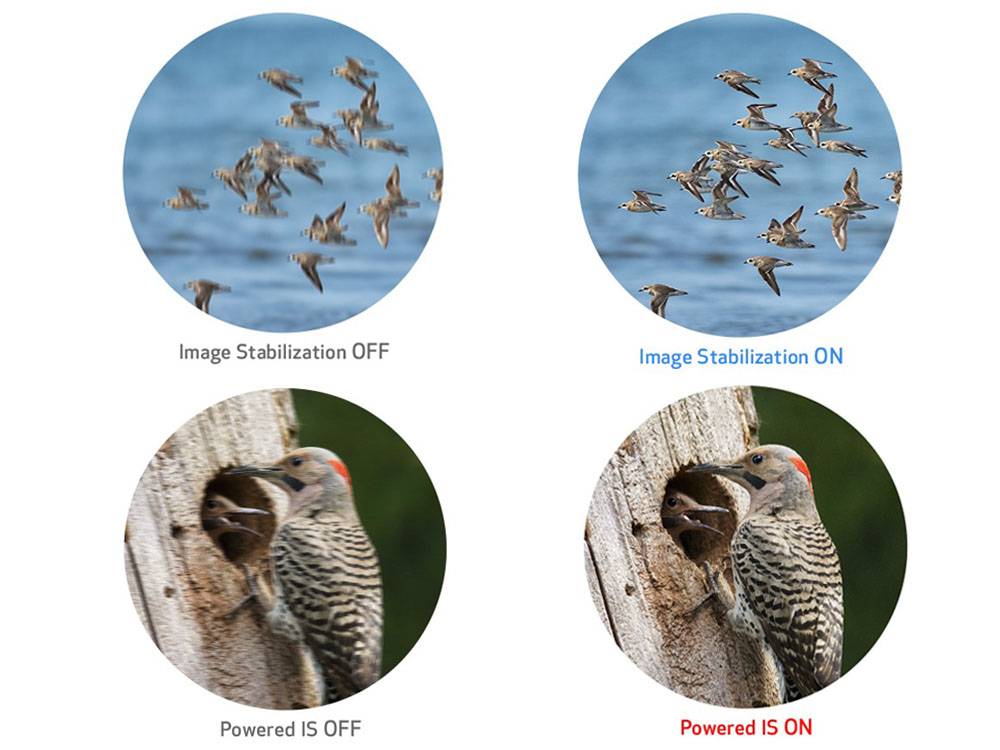 The basic form of IS works electronically using motion-sensors with prisms that “correct” the light so it remains stationary.
The basic form of IS works electronically using motion-sensors with prisms that “correct” the light so it remains stationary.
In 2017, Canon introduced a new Lens Shift Image Stabilization system in 10x, 12x, and 14x models. All their binoculars feature some form of stabilization.
Effect of IS in Canon Image Stabilizer Binoculars:
Superior Optics
Canon has been making optical equipment for 80 years, and they’ve stayed current. Their binoculars come with a premium, but they do have superior optics. They do this even in the face of their own technology.
Stabilizing an image causes inevitable quality deterioration, and Canon has chosen the route of abandoning the bargain market and doing the job properly.
The optical components are high-grade and the light chamber uses special molecular-level film coatings to maximize light transmission. All this optical engineering overcomes much of the loss caused by IS correction. They do charge for this, of course.
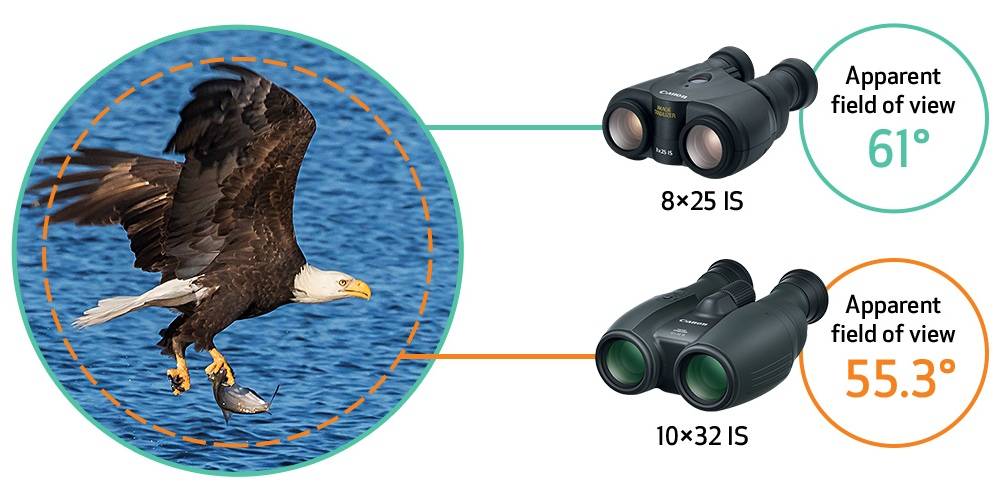 One highlight to note about Canon optics is that the image is very consistent. Some binoculars have a definite “sweet spot”, usually in the center, where the image is at its best.
One highlight to note about Canon optics is that the image is very consistent. Some binoculars have a definite “sweet spot”, usually in the center, where the image is at its best.
Outside of this spot the image degrades quickly, but Canon’s binos maintain their high-quality image almost to the edge.
All-Weather Construction
Canon is a bit annoying here. They can and do make top-notch water-proof binos. Well-constructed, long-lasting. Water-proof, not water-resistant. Awesome.
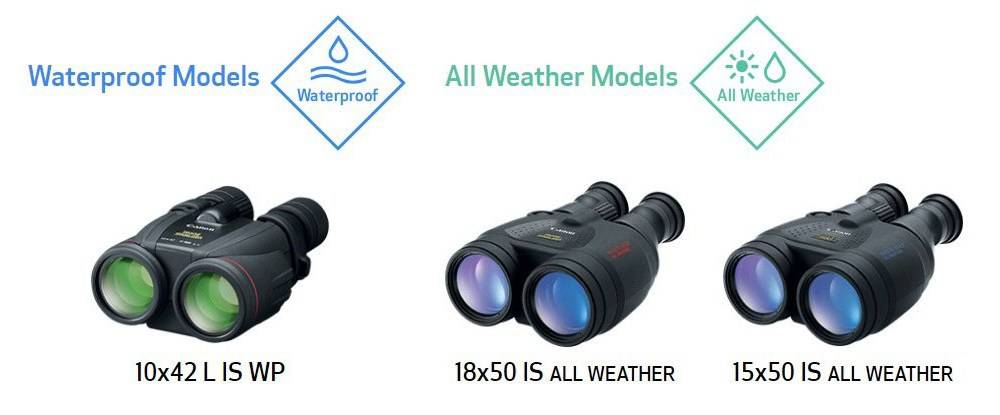 The company makes some really great binoculars with perfect optics for outdoor environments. The ergonomics are good, and the feel is consistent across their whole line. Their newest releases are fantastic, optically.
The company makes some really great binoculars with perfect optics for outdoor environments. The ergonomics are good, and the feel is consistent across their whole line. Their newest releases are fantastic, optically.
And then, on some of these wonderful birder models — the newest ones, even — Canon skips the water-proofing altogether … leaving you with huge opera glasses that need to be carefully kept indoors. Whatever.
Final Thoughts
Canon has been a leader in consumer optics for many years: they were the first to put image stabilization in their binoculars, and earned a good name for doing it.
How far they have ridden on those innovative coattails is a debate, but few argue that Canon sets a standard for optical quality. You can get what you want, but you will pay.
You buy a Canon for the image quality, and you buy Canon binoculars for image stabilization. Being able to raise binoculars and see a tripod-steady crisp, colorful view takes the experience up a notch.
The fact that Canon supplies each of its binoculars with a baseline of excellent IS and optics means you can’t go far wrong with this brand.
Quality: 4-stars
Price-Quality Value: 2-stars
Design: 4-stars
Features: 4-stars
Ease of Use: 5-stars
